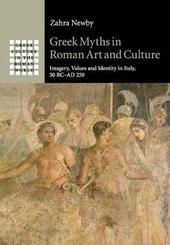
|
Greek Myths in Roman Art and Culture: Imagery, Values and Identity in Italy, 50 BC-AD 250
Paperback / softback
Main Details
| Title |
Greek Myths in Roman Art and Culture: Imagery, Values and Identity in Italy, 50 BC-AD 250
|
| Authors and Contributors |
By (author) Zahra Newby
|
| Series | Greek Culture in the Roman World |
|---|
| Physical Properties |
| Format:Paperback / softback | | Pages:415 | | Dimensions(mm): Height 245,Width 170 |
|
| ISBN/Barcode |
9781107420731
|
| Classifications | Dewey:937.07 |
|---|
| Audience | | Professional & Vocational | |
|---|
| Illustrations |
8 Plates, black and white; 107 Halftones, black and white; 10 Line drawings, black and white
|
|
Publishing Details |
| Publisher |
Cambridge University Press
|
| Imprint |
Cambridge University Press
|
| Publication Date |
16 January 2020 |
| Publication Country |
United Kingdom
|
Description
Images of episodes from Greek mythology are widespread in Roman art, appearing in sculptural groups, mosaics, paintings and reliefs. They attest to Rome's enduring fascination with Greek culture, and its desire to absorb and reframe that culture for new ends. This book provides a comprehensive account of the meanings of Greek myth across the spectrum of Roman art, including public, domestic and funerary contexts. It argues that myths, in addition to functioning as signifiers of a patron's education or paideia, played an important role as rhetorical and didactic exempla. The changing use of mythological imagery in domestic and funerary art in particular reveals an important shift in Roman values and senses of identity across the period of the first two centuries AD, and in the ways that Greek culture was turned to serve Roman values.
Author Biography
Zahra Newby is Reader in Classics and Ancient History at the University of Warwick. She is author of Greek Athletics in the Roman World: Victory and Virtue (2005) and numerous articles on Philostratus and Lucian, Greek cultural identity in the imperial period, as well as on mythological sculpture and sarcophagi. She also co-edited the volume Art and Inscriptions in the Ancient World (Cambridge, 2007).
|